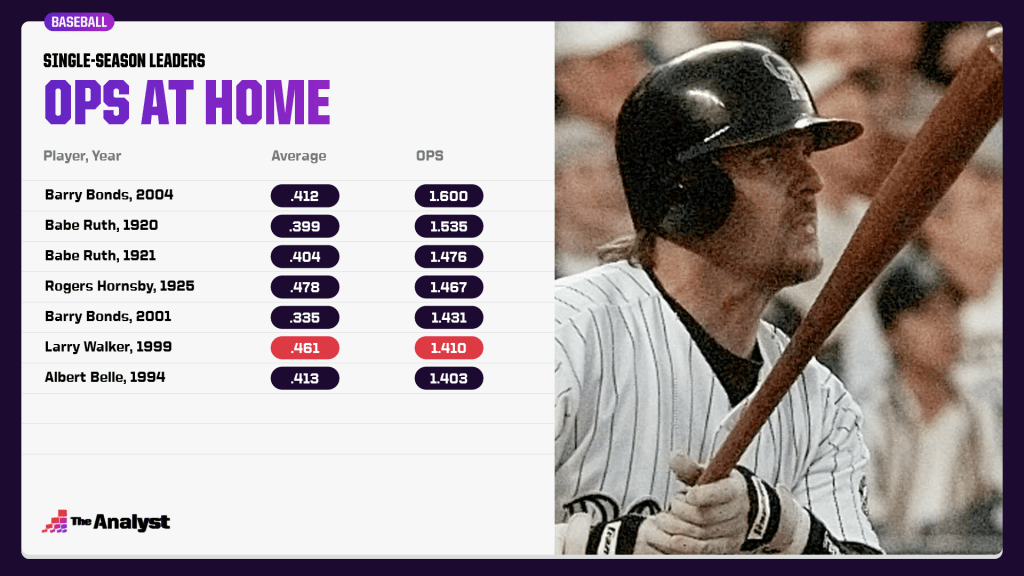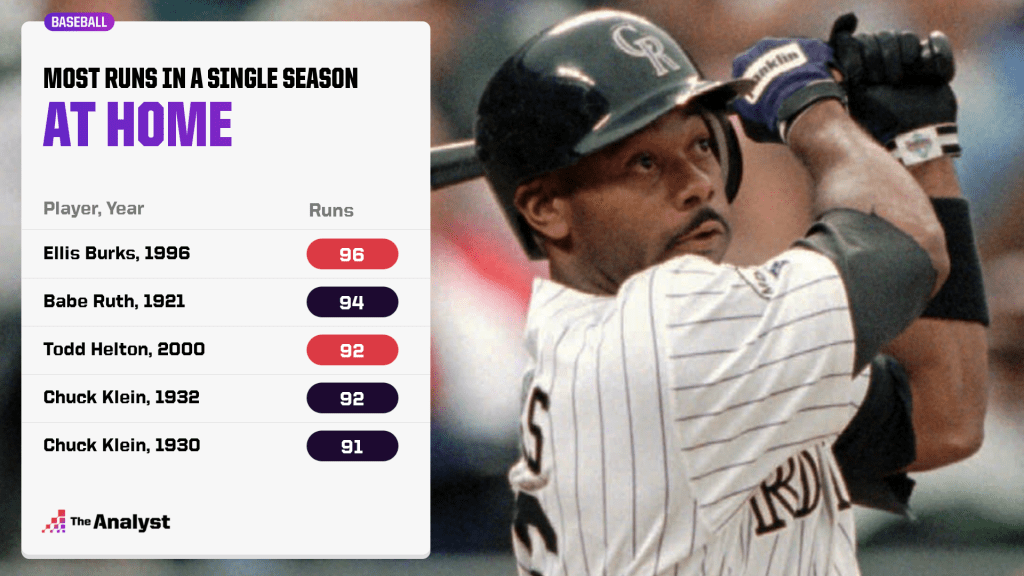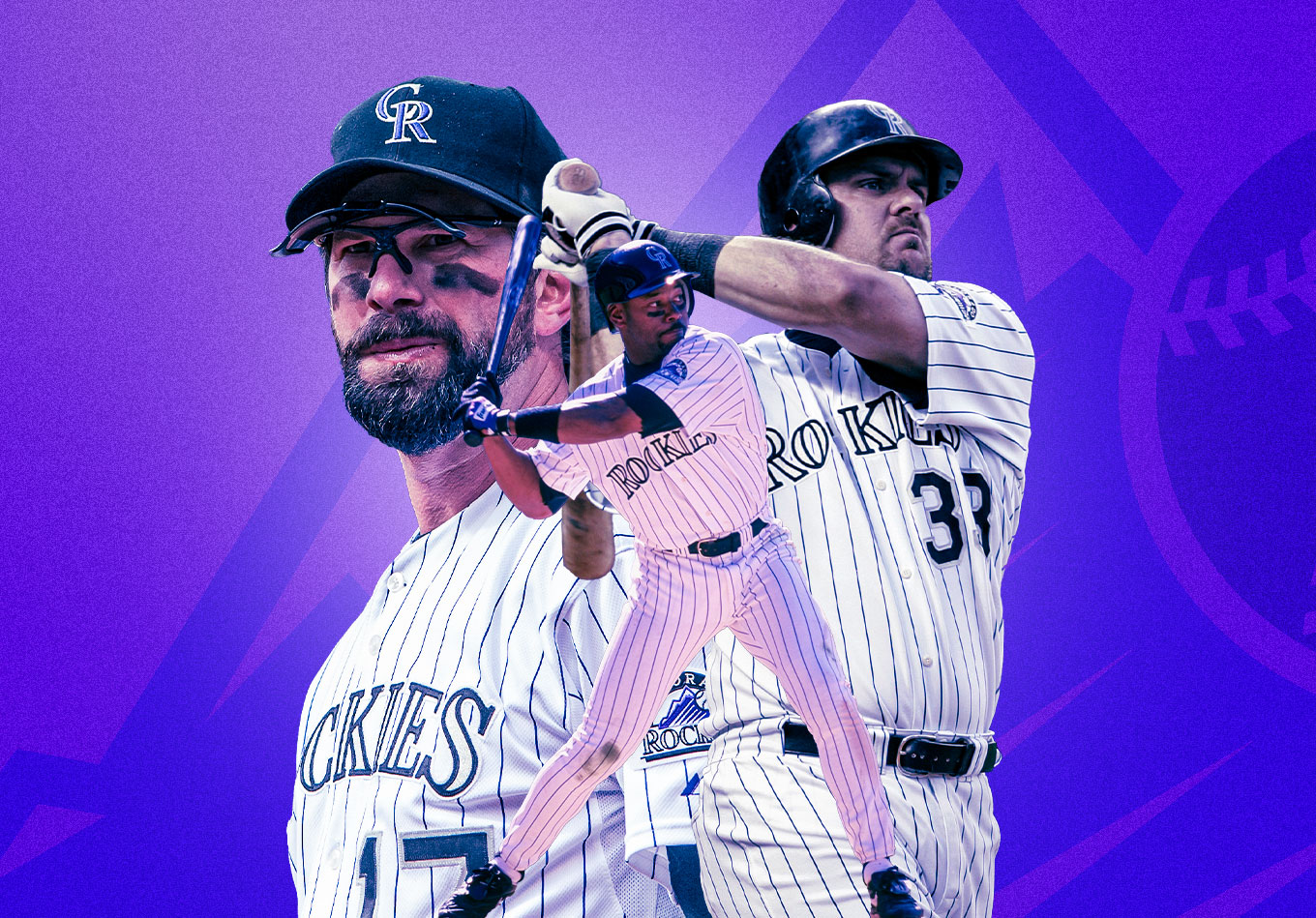As the best offensive ballpark in baseball hosts this week’s All-Star festivities, we’re looking back on the greatest single-season performances in its history – from Dante Bichette to Todd Helton to Jeffrey Hammonds (you’ll see).
There have been many football-type baseball scores, a wealth of prodigious longballs, several historic offensive slash lines and more than a few battered hurlers.
But that’s what we love about Coors Field, which takes center stage during MLB’s All-Star break this week.
The story of the launching pad known as Coors, which opened in 1995, is a story about hitting baseballs – hitting baseballs hard and far and frequently while wearing purple and black on Blake Street in the Lower Downtown neighborhood of Denver.
It certainly doesn’t take a long look back into the record books to find moving evidence of how hitting at Coors has impacted the hosts. This season, the Rockies are hitting .280 with 59 home runs and 99 doubles while averaging 5.6 runs over 48 home games. They’re batting .204 with 25 homers and 54 doubles while putting up 2.8 runs over 43 on the road.
They’re on pace to finish with the eighth-largest difference between batting average at home and on the road and fifth-largest difference between runs per game at home and away since 1901. As one might expect, the Rockies hold eight of the top-10 spots in the batting average category and nine of the 10 in runs per game differential.
Outfielder Yonathan Daza is hitting just .243 away from Coors this season, but he’s sixth in the majors with a team-best .336 home batting average. Though first baseman C.J. Cron only has three homers and a .682 OPS on the road, he’s hit nine home runs in Denver and ranks 11th in MLB with a .970 home OPS.
This is about the numbers and individuals behind hitting those baseballs, not the environmental elements or offensively advantageous moments in time that combined to make up the numbers. Park-adjusted factors are great, and we love using them, just not right now. For once, we’re gonna dumb it down and embrace the spectacle of a place that’s now been a part of baseball for longer than some MLB players have been alive.
A home game in Denver is different than a home game anywhere else. Here are seven of the individual Coors Field seasons that deserve revisiting:
LARRY WALKER, 1999
Walker in 1999 hit .461 at home, which is a number that when related to batting average in the majors makes one consider typos. It’s a very good batting average – so good that it’s the sixth-best home batting average dating to 1904, and it’s the only post-World War II batting average in the top 17. No. 18? Larry Walker 1998, but back at a mere .418.
Single-Season Home Batting Average Leaders
| Year | Player | Team | Average |
|---|---|---|---|
| 1912 | Joe Jackson | CLE | .480 |
| 1925 | Rogers Hornsby | STL | .478 |
| 1920 | George Sisler | STL | .473 |
| 1924 | Rogers Hornsby | STL | .469 |
| 1933 | Chuck Klein | PHI | .467 |
| 1999 | Larry Walker | COL | .461 |
The Hall of Famer hit .379 overall in ’99. That led baseball, as did his .458 OBP, .710 slugging and 1.168 OPS, yet he finished 10th in the National League MVP voting.
It seems 37 total home runs just didn’t cut it in 1999, two years after winning the MVP with a franchise-record 49 homers (tied with Todd Helton 2001). In 1999, 26 of those 37 came at home, where that ridiculous average was accompanied by a 1.410 OPS, which is the highest ever single-season OPS by a qualifying player at Coors.
That home mark has been topped by five individual seasons and three players, and we’ve only got one player beyond that who’s ever posted a home OPS of 1.400 or better.

Oh, and Walker’s .531 home OBP that season is the only to surpass .490 in a season for a Colorado player while his .879 home slugging percentage is more than 100 points higher than the next best (Todd Helton’s .774 mark in 2001).
Speaking of Todd…
TODD HELTON, 2000
Y2K ended up being a non-event, but let’s submit this among the evidence that all was not well in the year 2000: Helton did not win the NL MVP.
Helton led baseball – all of it, not just the NL – in batting average (.372), slugging (.698), OPS (1.162), total bases (405, 24th all time) and RBIs (147) and again, did not win the MVP (He trailed only Alex Rodriguez in WAR).
Other players this has happened to are identifiable in the baseball canon by their first name alone: Ted and Lou. In fact, only five players dating to RBIs becoming official in 1920 have led baseball in all those categories, MVP or not:
- Todd Helton, 2000
- Mickey Mantle, 1956
- Ted Williams, 1942
- Jimmie Foxx, 1938
- Lou Gehrig, 1934
That’s without even boiling this down to his home numbers. In 2000, Helton drove in 88 of his 147 runs at home, but that’s not a historically noteworthy total (tied for 28th all time) and fifth among Rockies.
He hit .391 at home, but he also hit .353 on the road, which is to say he was more balanced than we tend to think when considering the Coors Field inflation factor. That makes it that much more perplexing he wasn’t taken seriously as an MVP candidate.
And then there’s his predecessor at first base…
ANDRES GALARRAGA, 1996
No Rockies player has ever hit 50 home runs in a season, which is kind of surprising.
One Rockies player has driven in 150 runs in a season. Galarraga landed on that number in 1996, and 103 came at home along with 32 of his 47 homers. Both the Big Cat’s home run and RBI totals that season are franchise records at home. His .245 road batting average is not.
But that might not have even been the best home season for a Colorado player that season…
ELLIS BURKS, 1996
Burks is a bit of an oh-yeah character in the mid-90s lineups, as in you forget about him until he’s mentioned, which makes you say, “Oh yeah, Ellis Burks, I forgot about him.”
But Burks scored 96 runs at home that season. That’s more than – well – everyone. Not just that season. Everyone ever. Coors Field or not. Most all time.

His 129 home hits that season are tied for 12th all time and the most in the history of Coors Field – one ahead of Dante Bichette in 1998 and Jeff Cirillo in 2000.
His 392 total bases trail Walker (409 in 1997) and Helton (405 in 2000 and 402 in 2001), but his 241 at home are a single-season franchise record and tied for fifth all time.
Single-Season Total Bases at Home
| Season | Player | Team | Total Bases |
|---|---|---|---|
| 1932 | Chuck Klein | PHI | 270 |
| 1930 | Chuck Klein | PHI | 259 |
| 1936 | Hal Trosky | CLE | 251 |
| 1938 | Jimmie Foxx | BOS | 243 |
| 1996 | Ellis Burks | COL | 241 |
| 1920 | George Sisler | STL | 241 |
Burks hit 40 home runs, drove in 128 runs and 32 stolen bases that season, but he wasn’t particularly close to leading the team in any of those categories.
CHARLIE BLACKMON, 2017
We could write all day about what happened at Coors in the mid-to-late 90s and early 2000s and dig deep into players like Vinny Castilla and Eric Young. Or we could enter present-day baseball.
Blackmon hit .391 at home in 2017. His .773 slugging is third highest ever in a single season at Coors. But the man also hit 13 triples at home. That’s the most ever by a Rockies player, and only 20 players in the history of baseball have had more home triples in a season.
Blackmon posted a 1.239 home OPS, which is the highest since the Coors Field humidor went into use in 2002 and the best by any Colorado player not named Helton or Walker.
Inexplicably, Blackmon is hitting .242 with a .698 OPS at Coors this season, compared to .286 and .750 marks on the road.
Well, that was fun but back to the mid-to-late 90s and early 2000s.
JEFFREY HAMMONDS, 2000
Hammonds played exactly one season for the Rockies, which makes him an interesting Coors Field case study. Prior to that one season, Hammonds was often a bench player and occasionally a minor leaguer.
From 1993-99, he was a .268 hitter with a .783 OPS. His pre-Colorado magnum opus of a season was 1997 with Baltimore in which he hit .264 with an .809 OPS, 21 homers and 55 RBIs.
In 2000, he hit .335 with a .924 OPS and 20 home runs while driving in 106 runs in 122 games. His home average was .399, and 14 of his homers came at Coors. He was hitting .448 at home until Aug. 19, then he ended the season by going 13 for 53 (.245) in his final 14 Coors games before moving onto Milwaukee the following season.
He hit .246 with 22 home runs and 82 RBIs in his 276 career games that followed.
DANTE BICHETTE, 1995
We’ll end in the year this all started. Bichette hit 31 of his 40 home runs in Colorado as Coors Field opened its gates. That 77.5% share matched the highest ever among those who hit at least 40 homers. The Major League Baseball season was 144 games following a strike, so those 31 homers came in 71 games.
Among those to hit at least 30 total homers, he’s third in home percentage:
Highest Percentage of Home Runs at Home in a Season
| Season | Player | Team | HRs at Home | Total HRs | Home% |
|---|---|---|---|---|---|
| 1922 | Ken Williams | STL | 32 | 39 | .821 |
| 1982 | Bob Horner | ATL | 25 | 32 | .781 |
| 1995 | Dante Bichette | COL | 31 | 40 | .775 |
| 1948 | Ralph Kiner | PIT | 31 | 40 | .775 |
| 1942 | Mel Ott | NYG | 23 | 30 | .767 |
| 2010 | Carlos Gonzalez | COL | 26 | 34 | .765 |
| 1932 | Chuck Klein | PHI | 29 | 38 | .763 |
| 1991 | Frank Thomas | CWS | 24 | 32 | .750 |
| 2006 | Vernon Wells | TOR | 24 | 32 | .750 |
| 2004 | Moises Alou | CHC | 29 | 39 | .744 |
Bichette’s first homer that season? A three-run walk-off on April 26 to open Coors Field in fitting fashion. The final score was 11-9.
Taylor Bechtold contributed. Design by Matt Sisneros. Research support provided by Stats Perform’s Austin Streitmatter.
